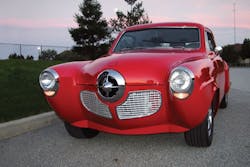Tom Mills didn’t want a 1957 Chevy. According to Mills, “everyone,” has one of those models, and he didn’t want his major restoration project to become an afterthought at car shows, lost in the sea of popular Chevrolet Bel Airs and Delrays. Rather than become an owner of a restored classic that has become a quintessential piece of auto shows, Mills had something else on his mind.
Coerced by a friend, and feeling nostalgic for the days when he worked at the Studebaker flagship dealership in his hometown of South Bend, Ind., Mills made the drive from Mishawaka, Ind., to New Mexico to pick up his most challenging project to date: a 1951 Studebaker Starliner coupe.
“The story about this mild custom coupe starts in a field in New Mexico, where it had been sitting for 25 years and was the local hotel for a herd of prairie dogs,” Mills said. “It was absolutely amazing preservation since it’s so dry as it is. There was no rust at all, every nut and bolt came out. My friend had it on his property out there, and he caught me in a weak moment and I said OK.”
Mills, who runs Jefferson Auto Collision Service in Mishawaka, brought the car back to his own shop—a homecoming of sorts, since the car came from the South Bend factory—and started the endeavor by removing the body and modifying the Studebaker chassis by adding a K-member and additional bracing. Up front, he installed tubular style control arms and coil springs, power rack and pinion steering, and power disc brakes.
Its power comes from a GM ZZ4 355hp crate engine with an Edelbrock 600-cfm carburetor and Sanderson cast headers. The transmission is a GM 2004R overdrive unit.
“It’s pretty reasonable for a new engine assembly complete,” Mills said. “It’s a good engine for that kind of modification, smooth and quiet, a great power plant.”
The tilt-telescopic Cadillac steering column was mounted in a Studebaker housing and cruise control was installed. Mills kept the same theme for the time period in the car, and used three gauges from Classic Instruments across the dash to give it an authentic look. Mills painted it Torch Red with Glasurit Urethane basecoat/clearcoat.
“I have a thing for red,” Mills said. “For a while everything I had was red... . I knew what I wanted. I was looking to get a ’50s custom look with modern running gear. Lincoln seats, cruise control; I built-in front and rear A/C, remote windows. I used Classic Instruments. Same motif originally in the car. People tell me it looks like an original, but it’s really an upgraded original.”
Mills didn’t log the hours he spent working on the project, but he began restoring the Studebaker in October of 1998 and first drove it in the spring of 2007. He hasn’t paid close attention to the cost of the project, either, but speculates he spent three times what the car is worth in parts alone to make it look show-quality and run.
Mills said the project took a lot of work, but was happy to restore a piece of his previous life, when he worked at the Studebaker factory dealership. Mills hasn’t done a project like that before, and he said he doubts he will again.
“I have built a couple of roadsters from scratch and [from] the frame when I was younger and had more ambition,” Mills said. “I’ve never done a rotisserie restoration like this. I’m 74 now, and about all I’ve ever done my whole life is modify custom cars.”
